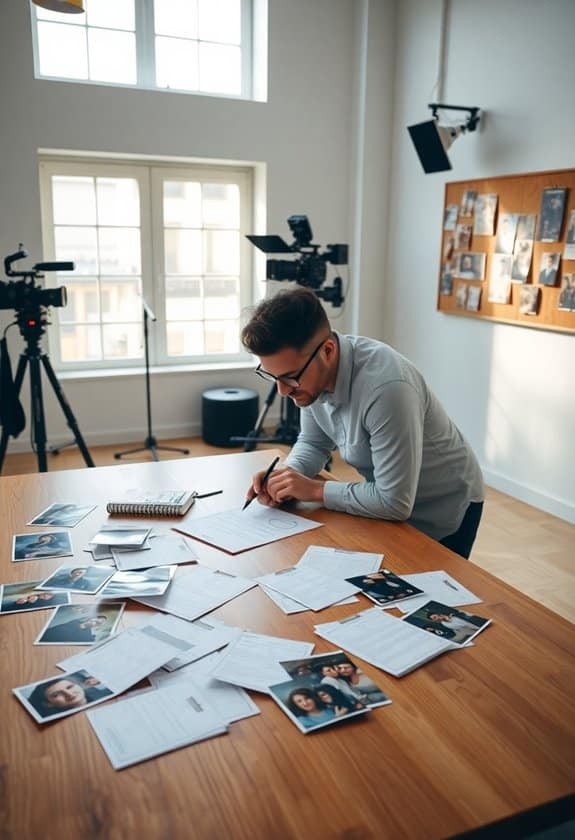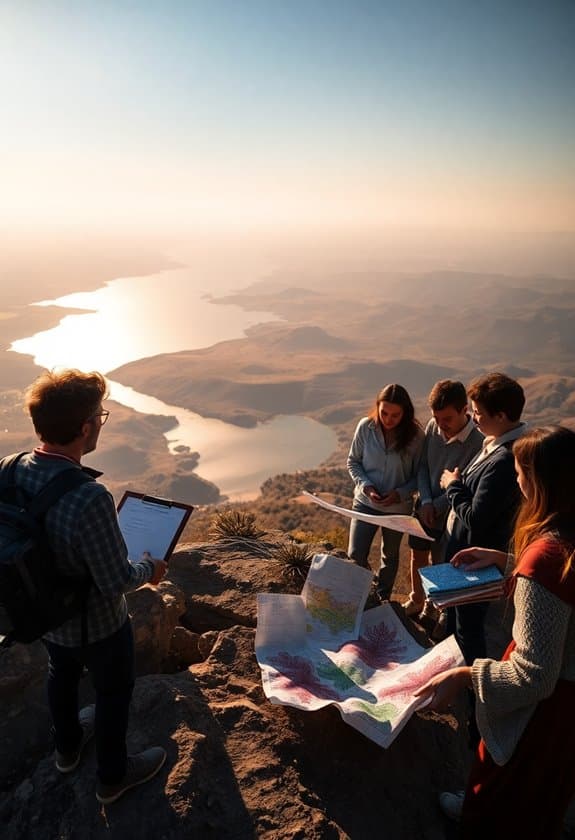Jumping into filmmaking? You’ll need an exceptional pre-production checklist to steer your project to success. Start with script and storyboard planning; think of it as your movie’s treasure map, preventing any scenes from hiding in the shadows. Then, choose a cast and crew who share your vision; trust me, the right team makes magic happen. Location scouting is like hunting for the perfect stage, ensuring safety and accessibility. Budget wisely, leaving room for surprises like snack attacks. And finally, nail down your schedule with military precision. Stick around to uncover the finer details that keep your film on track!
Important Highlights
- Develop a comprehensive script and storyboard to plan scenes and determine equipment needs.
- Conduct thorough casting and crew selection to ensure a shared vision and safe environment.
- Scout locations for safety, accessibility, and necessary permits to prevent legal and logistic issues.
- Create a detailed budget, including contingency funds, to manage financial resources effectively.
- Establish a detailed shooting schedule with backup plans to handle unforeseen disruptions.
Script and Storyboard Planning

Script and storyboard planning is the vital first step in pre-production that sets the foundation for your film.
Imagine building a house without a blueprint—chaos, right? Well, it’s the same with filmmaking! When you start, think of your script as your trusty map. It guides you, making certain you know exactly where you’re headed.
And then, there’s the storyboard, your visual GPS. It helps you visualize each scene, making sure everyone’s on the same page.
I remember my first film; without a clear storyboard, we ended up filming a scene twice because we missed a pivotal shot.
Don’t make that mistake! Planning these elements carefully guarantees your project runs smoothly, keeping everyone safe and on track, and maybe even saving you from some hilarious mishaps. Additionally, having a well-defined script can help you determine your essential filmmaking equipment needs early on, ensuring you are fully prepared for the shoot.
Casting and Crew Selection

With your script and storyboard in place, you’re ready to bring your film to life by focusing on casting and crew selection. Imagine your favorite movie without the perfect actors or skilled crew—it just wouldn’t work!
Start by holding auditions in a safe environment, guaranteeing everyone feels comfortable. It’s like hosting a fun game, but with scripts. Trust your instincts; if someone fits the role, you’ll feel it!
For the crew, pick people who share your vision and prioritize safety on set. Remember, filmmaking is teamwork.
My first film taught me that good crew members are like superheroes—they make the impossible possible! Ascertain everyone understands their role and respects each other. This creates a friendly atmosphere where creativity thrives.
Location Scouting Essentials

Securing the perfect location is like finding the right setting in an enthralling novel—it sets the tone for your entire film. When you’re out scouting locations, you’ll want to guarantee safety and suitability for your cast and crew.
Here’s a checklist to help guide you:
- Safety First: Always prioritize locations that offer safe environments. Check for hazards like slippery floors or unstable structures. Trust me, you don’t want an unexpected trip to the ER!
- Accessibility: Make sure the location is easy to reach for everyone involved. Consider parking, public transport, and nearby facilities.
- Permits and Permissions: You’ll need the right paperwork to film in specific areas. Double-check local regulations to avoid any legal hiccups. Getting kicked out mid-shoot is no fun!
Budget and Financing Setup

Crafting a solid budget and securing financing are essential steps that lay the groundwork for a successful film production. Imagine planning your film as a treasure hunt, and your budget is the map. It guides you, ensuring you don’t hit any scary financial traps.
Start by listing every possible expense you can think of—actors, props, costumes, you name it. I remember once forgetting to budget for snacks, and let me tell you, a hungry crew isn’t a happy one!
Next, consider how you’ll gather the funds. Will you crowdfund, seek investors, or maybe ask Aunt Sally for a loan? Each option has its quirks, but the goal is to keep your project afloat.
Safety lies in preparedness, so be thorough and realistic!
Scheduling and Logistics Management

Effective scheduling and logistics management can make or break your film production. I remember one time when a delay in logistics almost caused a major setback—talk about a nail-biter!
To keep things running smoothly, focus on these key areas:
- Create a Detailed Shooting Schedule: Break down your script into scenes and prioritize them. Make certain to take into account the availability of locations and cast. This will help you avoid any last-minute scrambles.
- Coordinate Transportation and Equipment: Ascertain that everyone and everything arrives safely and on time. Double-check all routes and equipment bookings to avoid any surprises.
- Plan for Contingencies: Always have a backup plan. Weather changes, and equipment failures—trust me, they happen when you least expect them. Being prepared will save you a lot of stress.
Frequently Asked Questions
How Do I Ensure Legal Rights for Music and Sound Usage in My Film?
Did you know that about 90% of films face legal issues over music rights?
To keep your film safe, you’ve got to secure the proper licenses. Start by identifying whether you need a sync license or a master license.
I once tried to skip this step, thinking it’d be okay, but it wasn’t!
Reach out to rights holders early, and don’t hesitate to consult a lawyer if things get tricky.
What Are the Key Considerations for Securing Insurance for My Film Production?
Securing insurance for your film is essential, much like wearing a helmet before a wild bike ride!
Consider coverage for cast, crew, and equipment. Imagine if a camera falls (yikes!). Insurance can save you big time.
Think about liability too; you don’t want unexpected mishaps costing you.
When I started, I underestimated its importance. Trust me, getting the right insurance lets you focus on creativity, not calamities!
How Can I Effectively Manage Post-Production Timelines and Deliverables?
Think of managing post-production timelines like herding cats—challenging, but doable with patience.
Start by breaking tasks into bite-sized pieces. Use a calendar to map out deadlines, ensuring everyone’s on the same page.
Communication is key; regular check-ins keep surprises at bay.
I’ve found that creating a buffer for unexpected hiccups can be a lifesaver.
What Steps Should I Take to Protect My Film’s Intellectual Property?
To protect your film’s intellectual property, start by registering it with the U.S. Copyright Office. It’s like giving your film a shiny badge of ownership.
Then, consider trademarking your film’s title if it’s unique. Use non-disclosure agreements with your crew to keep things hush-hush.
Also, don’t forget digital watermarks on your footage. They act like invisible fingerprints, making sure everyone knows it’s your masterpiece.
Stay savvy and keep your film safe!
How Do I Create a Marketing Strategy for My Film’s Release?
Creating a marketing strategy for your film’s release is like planning a big party, and you want everyone to come!
Start by identifying your audience—who’s your film for? Use social media to your advantage; post fun sneak peeks and behind-the-scenes shots.
Collaborate with local theaters for screenings and Q&A sessions. Don’t forget to create a catchy trailer.
For my first film, I made flyers myself; it was exhausting, but totally worth it!



